Erin's story:
How trailblazing maternity leave in a male-dominated tech environment led to a parental leave policy overhaul
We don’t have an obligation to make things better for people who succeed us, but those who do are the ones who move us forward. When Erin came back from parental leave at The New York Times with a new outlook on what new parents really needed (like more paid time, direction, and support), she made sure others after her would have competitive options for parental leave.
Erin spent two years leading the redesign of NYTimes.com when she found out she was pregnant. She was used to climbing the corporate ladder and was good at it; she had gotten promoted every year. But she was apprehensive about the pregnancy’s potential effect on her career track, especially in a male-dominated tech environment.
It doesn’t help when colleagues aren’t so graceful at handling the news. Insensitive comments were disheartening to Erin but ultimately motivated her to prove her success as a working mother: “I consciously decided that I was going to be an example. I was going to make it work.”
Erin applied the same rigor she used in her project management job to her coverage planning process. Aware that she was “going first” as an expecting leader at her company, she made sure everything was documented. Her plan served multiple purposes: a clear record of her contributions so that she wouldn’t lose any responsibilities, a template for future expecting parents to use for their coverage plans, and a helpful strategic planning document.
After a refreshing but short 12-week, partially paid parental leave sprinkled with work check-ins, Erin returned to work. After a few months of ramping back up, she was better than ever - more productive and more impactful.
But she had a realization: she wished she had been allowed just a few more weeks at home on leave. She noticed how other tech companies - those that were competing with The New York Times for talent - were offering at least 16 weeks paid parental leave.
So she combined forces with a few other women at The New York Times to put together a thorough proposal to overhaul their parental leave policy. They spent eight months fine tuning the proposal that would create competitive benefits to attract and retain talent.
Keep reading to see how Erin spearheaded a policy change giving parents 16 weeks of fully paid leave, plus tips on how she balances it all. Dive deeper below.


#1 How Erin changed the parental leave policy at The New York Times
Erin spent eight months working on an overhaul of the The New York Times parental leave policy. As a result, The New York Times increased their paid parental leave from 12 weeks partially paid for birth mothers to 16 weeks fully paid for birth mothers and 10 weeks for all parents.
Here is how Erin and her project team convinced the The New York Times to increase their paid parental leave:
- Explained the benefits of increasing paid parental leave - and backed them up by research: Erin and her team highlighted three main benefits:
- Competitiveness: Paid leave has shown to result in increased talent attraction and retention. The New York Times lost talent - particularly technologists - to tech companies that provided much more generous parental leave policies and benefits. Erin and her team also highlighted research, including an EY study that showed that receiving paid parental leave was one of the essential considerations when individuals are considering job offers.
- Equity: Equitable parental leave policies have proven to reduce workplace bias against women and support female retention, advancement, earnings, and retirement security. They also shared examples of how parental leave benefits men as well.
- Profitability: Providing an extended parental leave helps the bottom line, namely by increasing retention (which reduces replacement costs that can range from 20% - 200% of annual salary when you consider business disruption as the result of attrition). Research has shown that improved parental leave increases the likelihood that employees will return to work, improves morale, and has either a positive effect or no impact on productivity.
- Completed a competitive audit: They consolidated examples of how other similar companies handled parental leave. Fairygodboss is a great resource to search for relevant, competitive information. They collected as much information as they could find, including the amount of paid leave and eligibility requirements. They also asked their friends at specific companies to share details of their parental leave policies and benefits.
- Conducted a survey of working parents at The New York Times so that they could weave in stories from employees: Questions they asked included:
- Did you take as much time as you would have wanted? If not, why didn't you take more?
- Have you taken parental leave before, at The Times or another company? If yes, how did this leave compare?
- Did you find your manager and colleagues to be sufficiently supportive of you? Did you find the need to do work while on leave?
- Did you feel supported while transitioning out and back in? What kinds of things helped that transition?
- Does the updated parental leave policy make you feel more committed to The Times?
- Built a financial model to present to leadership: Their goal was to do as much legwork as possible so that the company could move forward quickly by the time Erin’s team presented their recommendations to leadership. Therefore, they fully modeled out what they expected the full costs of an increased parental leave policy to be for the company, as well as the expected ROI.
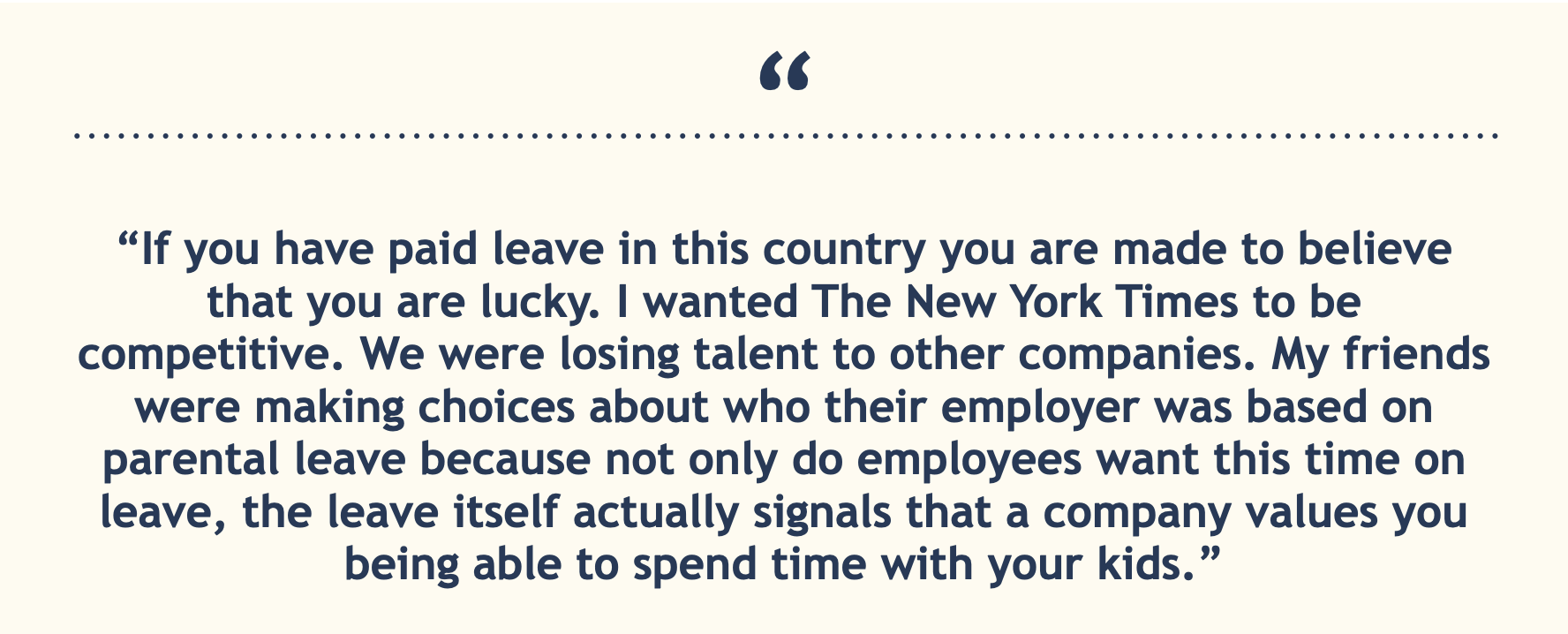
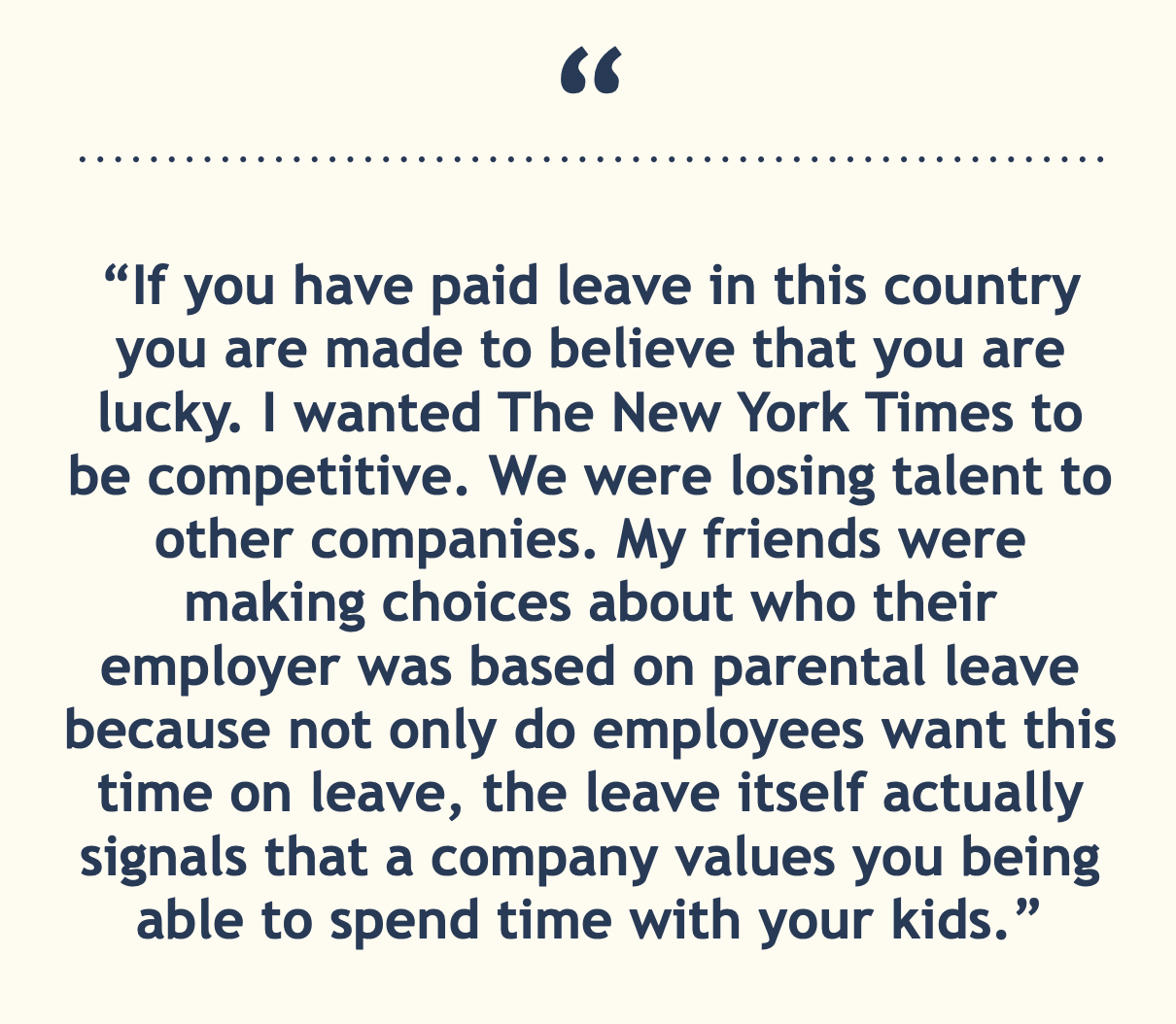
#2 How Erin approached her parental leaves
As Erin approached her first leave, she had very few resources or examples of going on leave and returning to work successfully. Therefore, she decided that she would invest a lot of time preparing for her parental leave so that her work and planning process could later be used as an example for other expecting parents at The New York Times.
Some highlights on how she approached her parental leave process include:
- Applied her project management skill set to coverage planning: Erin created an excel document that listed out in explicit detail every aspect of her job: projects she owned, meetings she attended, performance reviews, tools, and who to go to for what things.
- Built her coverage plan with a clear goal of documenting her role to ensure she could return with her responsibilities intact: Very few people have clear documentation of their roles. Without this, it could be easy for things to change a lot while an employee is out on parental leave, potentially to their detriment.
- Treated coverage planning as a professional development opportunity for her direct reports: She thought a lot about how she could provide positive stretch experiences to her junior team members while she was out. Instead of just asking them to take on more work, she was thoughtful in aligning the coverage responsibilities to their career goals so that they, too, would benefit from this work.
- Identified a lot of wasted activity, which helped her restructure her role after returning: “I tell people who don’t even go on maternity leave to create a coverage plan because it helps you identify where you are spending all of your time. When I came back to work, there were so many things that made me think, ‘that is ridiculous, I can’t believe I was doing that!’ I got to come back with the parts of my job that I really loved and eliminate the parts that I didn’t love.”
- Returned to work with a flexible schedule for one month: With her first maternity leave, she got 12 weeks partially paid, and used saved vacation time to work part-time the month she returned to the office. This allowed her to adjust to being a working parent on a better timeline.
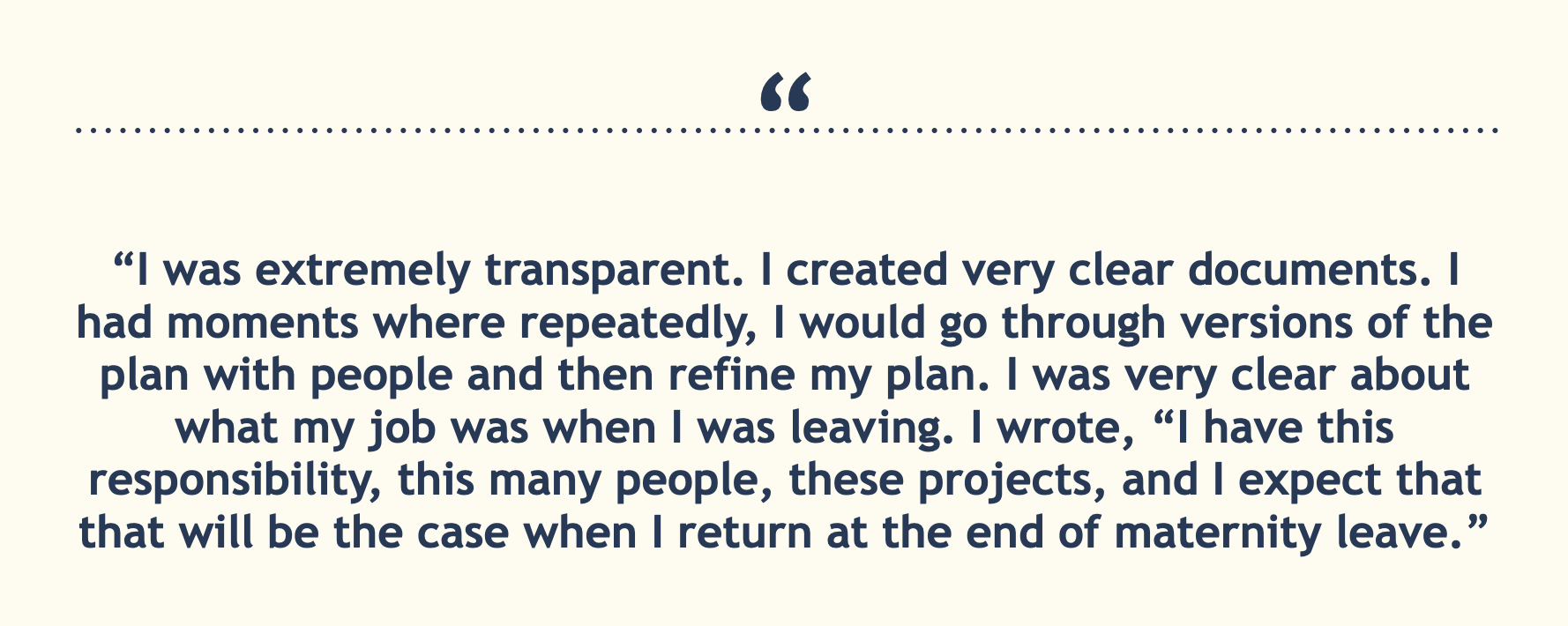
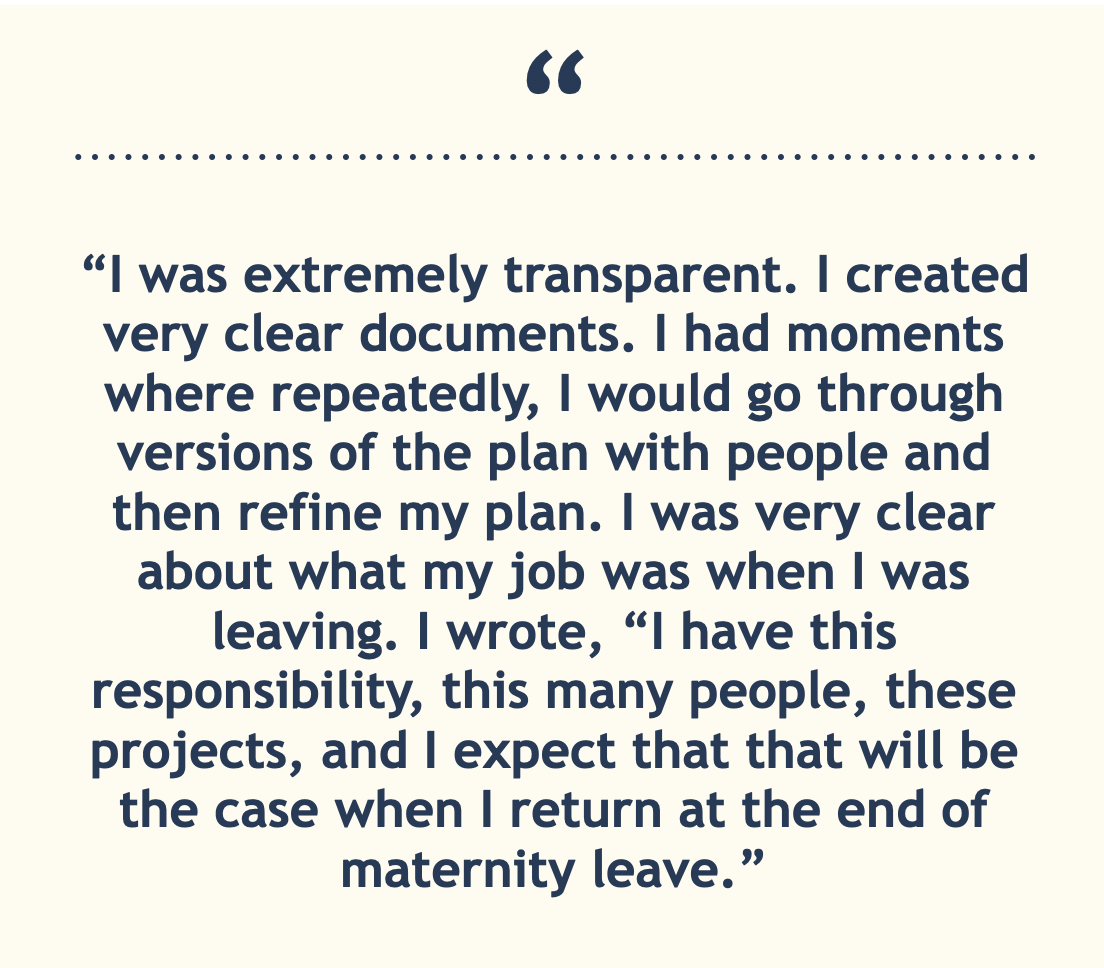
#3 Tips & tricks on how to set yourself up for success as a working parent
After spending seven years at The New York Times, Erin left in 2018 to join Away as their VP of Organizational Development where she helped scale the business from 50 to 550 employees globally, becoming a unicorn startup valued at $1.4 billion. After the “full startup experience”, as she calls it, she advised companies on talent and DEI strategy before launching her new company Charter which focuses on supporting the new hybrid workplace. Erin’s ability to streamline and simplify her home life directly impacted her ability to continue to seek out challenging new roles at earlier stage companies.
Her top tips and tricks about how to set up your home life to support your professional goals include:
- Block your calendar for family time: Every night from 6:00 - 8:00pm Erin blocks her calendar as “Matilda and Frankie time.” This both demonstrates to co-workers that this time is important, and establishes the routine of never working during these hours.
- Do meal planning: Every Sunday she plans out each meal and grocery shops for the week. She highly recommends The New York Times cooking app.
- Create a family calendar: As your kids get older, having a family calendar becomes much more important as you figure out who is doing what, when.
- Have an open conversation with your partner about which one of you will take on more professional risk at different stages: In Erin’s situation, they always try to have one person in something more “secure,” which allows the other to take more risk. This can change over time, as one person moves into something less risky so the other person can explore new opportunities.
- Have each parent completely “own” specific household items: Erin handles grocery shopping and household shopping, while her husband owns laundry. This works well because it’s clear who is doing what, and there is no ongoing negotiation.
- Schedule your workout time: Erin works out at 5:30 am at a local studio. This is hard, but this is the only time that consistently works for her. If she can’t make a 5:30 am class (like during COVID) she uses her Peloton app to do a workout at home at this time before the rest of the family is awake.
- Think about quality time over quantity of time: “Love is not measured in the number of hours that I spend with my kids.” How can you bring your kids into your life and do things you enjoy with them? How do you get them excited about your hobbies and do those things together?
- Teach your kids how to do chores, so you don’t have to do them: Start to outsource easier chores to your children at a young age. Even teaching them silly things like putting their dirty clothes into a specific place that makes laundry easier will help. It sets the foundation for eventually having them do more.
- Pay for things to buy you time: If you can afford to bring in a cleaner, that can free up important time to spend with your family. Think about the things that you hate to do and could pay someone a small amount to take off of your plate.
- Give the same gift to everyone: Erin buys children’s gifts in bulk and keeps them until her kids are invited to parties. Then she never has to worry about buying gifts because she has one standard gift she gives everyone that age.
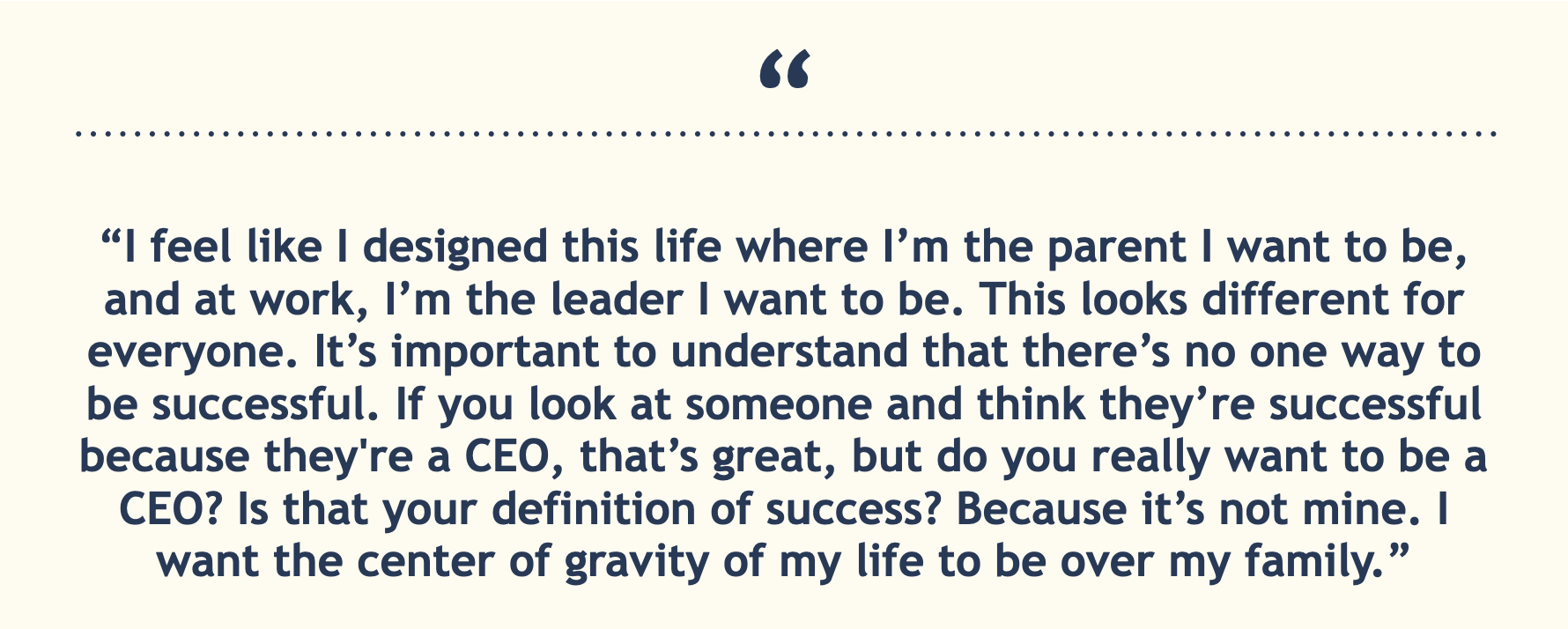
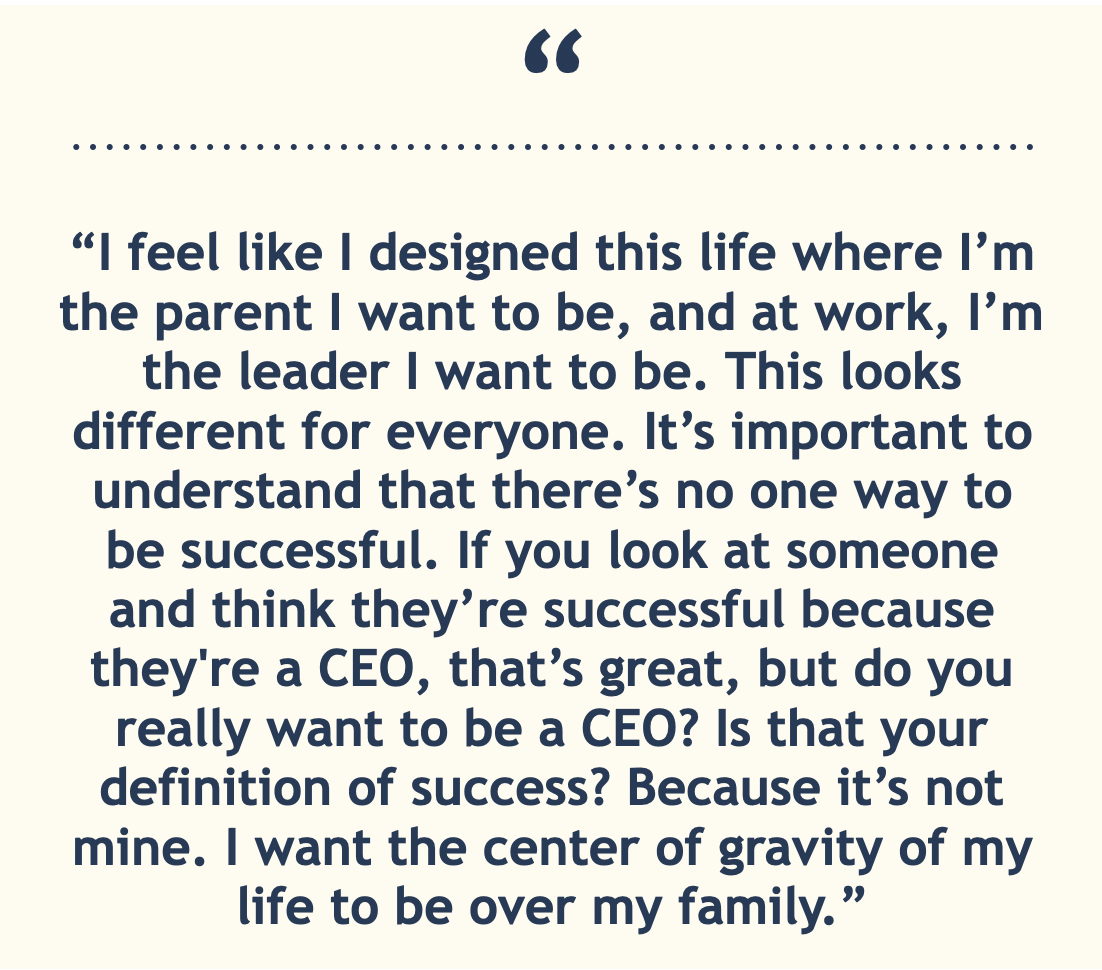
Want to read more of these stories?
We'll send them straight to your inbox every time we publish a new profile (two times per month).
Send them to me!

